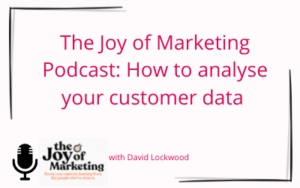By David Lockwood, Co-Founder and Insight Director, The Tapestry Agency
In the words of nineteenth-century retailer John Wanamaker: “Half the money I spend on advertising is wasted; the trouble is I don’t know which half.” Central to this is the question of campaign measurement, which remains as critical today as ever. But just because you’re measuring something, it doesn’t mean you should or that it’s important enough to be measured.
In a recent Retail Leaders Forum, I joined multi-channel DTC retailers for a lively debate on how best to measure campaign effectiveness, and four interesting observations came out:
1. Cost of recruitment must focus on incrementality
Measuring marketing at the campaign level is challenging because it can be measured in many ways. But ultimately, it boils down to what the campaign is delivering incrementally. And vital to achieving this, but often forgotten, is knowing your performance at the margin.
As you try to attract more customers, recruiting each new one gets more expensive. While you may understand your average cost per recruit, the likelihood of winning any new customer will be more costly at the margins. This means investing additional budget in any channel won’t yield the expected outcome based on this average cost.
The incremental cost of recruitment is well recognised offline, especially by experienced catalogue businesses. Here, when approaching any recruitment list, they’ll focus on breaking up the list to test and understand how much more expensive it is to recruit from the lower performing segments versus the higher ones. But in digital, people seem to forget this idea. So, adopt this best practice from the offline catalogue world, and it’ll stand you in good stead.
And when it comes to measurement, always remember averages distort your thinking. Yes, they help explain things quickly and are simple to understand and report, but they hide the truth.
For example, suppose you’re looking at the average cost per recruit in paid search. This encompasses a myriad of activities, including brand search, which is driven by above-the-line marketing activity, and long-tail generic search. Each comes in at a different price point, so the average doesn’t reflect what’s really happening. To truly understand your recruitment activity, avoid averages and focus on incrementality.
2. Marketing costs must include the cost of promotion
Many brands only consider media costs in their marketing costs calculation when measuring marketing efficiency. What’s often forgotten are promotional costs – the promotional discount you’re offering to entice someone to buy from you for the first time. And these can be high, sometimes even higher than your media costs.
To gain an accurate measure of marketing efficiency, the cost must include promotions, since media and promotion are needed to deliver a new recruit. In doing so, you can see the reality of what you’re spending, which is often more than you’re factoring in. Then you can understand your marketing decisions more clearly and experiment to find the best media and promotional spend combination to support your marketing goals.
3. Know what you’re measuring success against
With a wealth of campaign metrics available, it’s easy to get distracted from the critical question: what are you measuring success against? And this can be multiple factors.
Firstly, it must be the budget (or a re-forecast if the campaign isn’t going to plan). However, the budget must be built in a way that makes it easy to measure. This is achieved by building it up in reverse and basing it around how you want to measure it, including your expectations around customer acquisition, retention, and the predicted cost of both activities.
Secondly, you should measure it against previous activities. And this becomes challenging as we move into March because it’s the first March for several years where there’s a level of normality. This means March 2022 marketing responses should be more akin to what they were three years ago, rather than either of the last two.
And while it’s complex to do today, it’s still essential. Comparing to budget alone can produce an incomplete picture. Perhaps the budget set was not as robust as it could have been? Or you may be overachieving on specific metrics but underachieving in others compared with two years ago.
We’re working with a client that has quadrupled the size of its customer database since 2019. Its budget had been set around business growth, not customer numbers. So, while they were over-achieving on their budget target, this masked that their customer engagement, order rate, and lapse rate were in decline compared with 2019. Only by measuring against previous periods were they were alerted to this crucial insight.
4. Don’t view web metrics in isolation
When approaching your web metrics, if you’re focusing on traffic, traffic volume or conversion rates, it’s essential to understand these within the context of your broader marketing activities. And while averages are dangerous, they’re more so when it comes to online measurement.
Yes, a campaign may be driving on average 30% more traffic to a company’s website, but this could be good or bad, depending on the source. This extra traffic could be worthless if the source delivers low conversion rates. Conversely, high average conversion rates don’t necessarily indicate value. If the traffic comes from a promotional email to existing customers, then conversion rates should be higher as you’re preaching to the converted. If you’re relying on averages, you lose your campaign perspective.
And when measuring conversion, measure it in relation to what’s happening on your site at that point in time. Are results being driven by your campaign activity, or are user experience site changes, for example, contributing to improvements? Always look at activity as a whole and not in isolation to understand what’s happening.
Having a firm grasp on your metrics and ensuring you’re measuring the right things is critical for gauging marketing success. But always be aware of what you’re measuring and any implications your approach may have on accuracy or your decision making. Ultimately, if you focus on what matters and understand the revenue and contribution the campaign delivers, you can’t go far wrong. For more advice on building your business around the marketing metrics that matter, get in touch with the team at [email protected].




